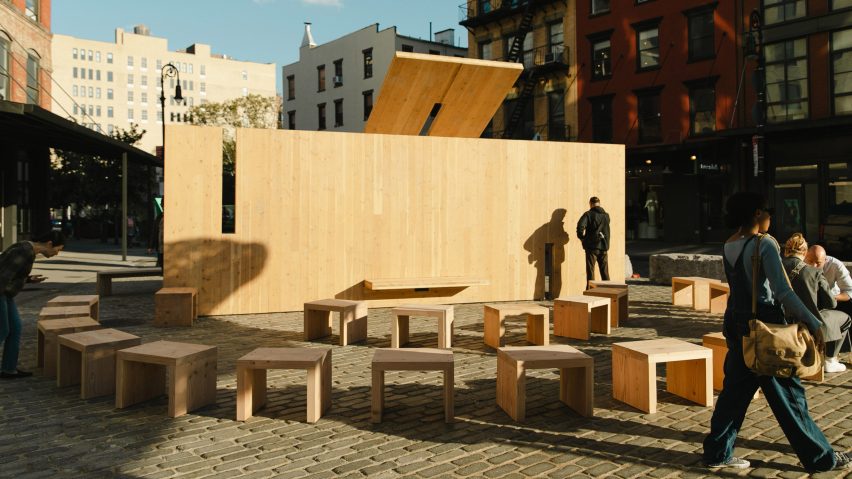A "sacred space" made from CLT panels and a cloud canopy made from strips of woven bamboo are among the pavilions being shown at New York City's Design Pavilion event.
Created by Shanghai-based studio llLab and designer Michael Bennett of Studio Kër, the two pavilions display sustainable building materials and techniques. The structures are on show for Design Pavilion, an event by NYCxDesign, part of the programming for the city's yearly architecture festival, Archtober.
"This is about materials," said NYCxDesign executive director and founder of Design Pavilion, Ilene Shaw. "They're both about materials. They're about strong, durable, sustainable architectural building materials."
Located in Gavensvoort Plaza in Manhattan's Meatpacking District, the exhibitions sit side by side.
llLab's Bamboo Cloud pavilion is a continuation of a previous project installed in the city of Guilin, China, where the studio created a series of canopies and inhabitable pods using strips of woven bamboo for shelter from rain.
In New York City, the pavilion takes a similar form, consisting of two amorphous "clouds" of bamboo supported by structural columns that run into silver-coated, organically shaped benches at each base.
"While still retaining the beauty of a handcrafted basket with its woven structure, the installation breaks the conventional boundaries of the material by boldly showcasing its strength," said the team.
"Composed of bamboo strips woven into a porous surface, the pavilion naturally uses its internal force for form finding and eventually stabilizes as a hollow space, which is structurally resilient with the potential to be used at building scale."
The uppermost structures were created with a hand-woven technique used by local populations in China, which the llLab team learned in order to create and assemble the pavilion.
llLab founding partner Hanxiao Liu told Dezeen the general shapes of the bamboo forms were created by local weavers "who understand bamboo".
Liu explained that while in Guilin, the pavilion was intended to connect people with nature, the Design Pavilion exhibition introduces passersby to the materiality of bamboo and provides a community space for its New York City neighbourhood.
"The most important thing is to make the neighbourhood enjoy the space," Liu said. "To make people feel the thing itself."
llLab worked with the lighting design studio L'Observatorie International to illuminate the pavilion at night, which is lit from underneath with a warm glow.
For the Public Display pavilion, designer Michael Bennett created a community space using large-scale cross-laminated timber panels.
One panel creates a structural wall, while the other rests against it at a gentle angle. A semi-circle of wooden chairs faces the vertical panel and a bench was installed on the other side, beneath the sloping CLT.
Thin, rectangular cut-outs were interspersed throughout the structure, with a large, central opening cut into the angeled panel.
"[It's] an opportunity to take the material and show it in its purest form," Bennett told Dezeen. "Not to do too much with it, is the idea. I could shred it and make something crazy, or I can show it in a way that's just enough so people can feel sacred space and also to get to interact with the material."
The installation also explores community and sacred spaces as a place of refuge, with nods to environments like a church.
"Can you be in a space that's surrounded by calamity but still feel a sense of clarity?" asked Bennett. "That's something I think about a lot."
Also part of the Design Pavilion exhibition is a series of animated digital portraits projected onto the four sides of the World Trade Center Podium, which spans 200 feet (60 metres).
Conceptualized by artist Marjorie Guyon as part of the ongoing I Was Here project, with video and animation co-created by Marc Aptakin, Roy Husdell, and Yoel Meneses of Yes We Are Mad, the animations depict "ancestor spirit portraits".
"When I was three, I took the ferry and climbed to the very top of Lady Liberty to see the land and sea through her eyes," said Guyon.
"Like the Statue of Liberty, the Ancestor Spirit Portraits of the I Was Here project are iconic – their presence allowing our city, our country, and our world to see through their sacred, ancient eyes,"
Design Pavilion is part of the NYCxDesign programming, which hosts the NYCxDesign Festival in May.
For the festival this past year, local designer Jean displayed birdhouses, seating and other public architecture at the Naval Cemetery Landscape and salvaged furniture found in New York's public parks were displayed in an abandoned Chinatown building for an exhibition by Marta Gallery.
The photography is by Jennifer Trahan unless otherwise stated.
Bamboo Cloud and Public Display will be on show at Ganesvoort Plaza in NYC from 12 to 19 October, with I Was Here running through 22 October. For more exhibitions, talks and events during New York's design week, visit Dezeen's dedicated NYCxDesign guide.

